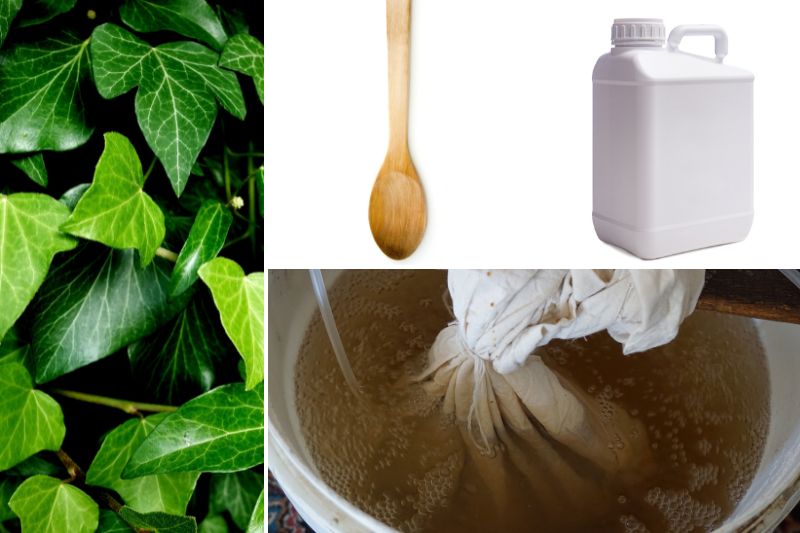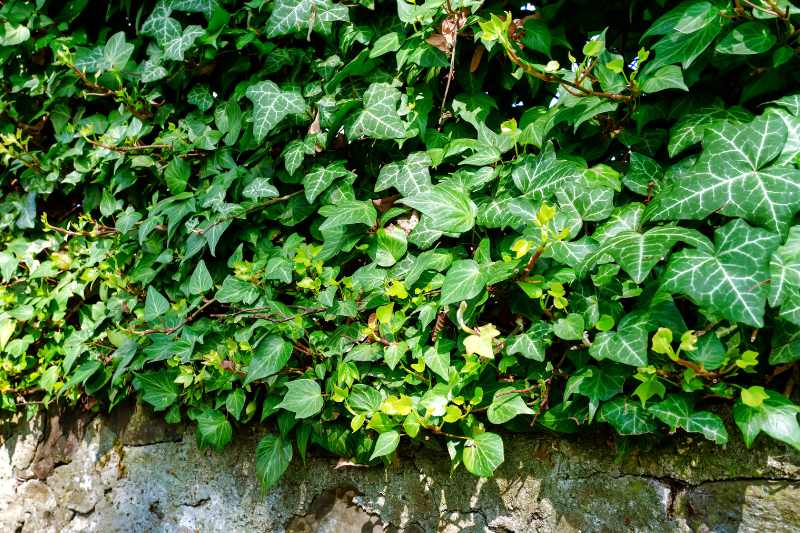Ivy manure has repellent and insecticidal properties against aphids, whiteflies and mites. Ivy manure can be used preventively or curatively, but always diluted! It's a natural alternative to care for your plants in both the vegetable garden and ornamental garden.
Let's discover how to prepare ivy manure and use it properly!
Required Materials
To make your ivy manure, you'll need:
- A pruner
- 2 buckets or any other non-metallic container to avoid oxidation (one for preparation, one for filtration)
- A clean cloth or piece of sheet
- A stick or old wooden spoon
- An opaque, airtight 10-litre container
- A pair of gardening gloves
- A funnel
- A kitchen scale
- A tablespoon
Which ivy to use for manure?
Common Ivy or Climbing Ivy (Hedera helix) should be used for making ivy manure. Other ivy species (Hedera hibernica or Hedera colchica) and horticultural varieties (with variegated or deeply cut foliage) can also be used, but it would be a shame to damage them.
When to make ivy manure?
Ivy is an evergreen climbing or creeping plant. Therefore, harvesting can be done year-round. However, keep in mind that manure maceration is preferably done within a temperature range of 15 to 25°C.
How to make ivy manure?
Ivy manure
You'll need 1 kg of ivy leaves for 10 litres of rainwater. If using tap water, let it sit for 48 hours outdoors before use to allow chlorine to evaporate. Choose young leaves, meaning those with light green colour.
Warning: The outdoor temperature should be at least 15°C but below 25°C. If it's too hot, the manure may rot.
- Roughly chop the ivy leaves using pruners or garden scissors;
- Place your ivy leaves in the water bucket (10 L): This bucket shouldn't be metal - wood or plastic works well. For easier handling, you can place the ivy leaves in a potato net or old winter fleece, making them easier to retrieve before filtration;
- Cover the bucket with cloth;
- Place in shade in a cool spot to avoid putrefaction and away from your home, as the manure may emit an unpleasant odour. Additionally, ivy contains active compounds that can be dangerous when inhaled in very high doses. Exercise caution and keep the manure away from children;
- Stir daily and vigorously for about ten minutes using an old kitchen utensil (wooden spoon) or simple stick;
- Let macerate for 5 to 10 days. The result depends on ambient temperature. The optimal range is 20-25°C. You'll notice a white film on the surface - this is normal, it's the saponin from the ivy leaves rising to the surface;
- To know when maceration is complete, observe the liquid when stirring. If bubbles remain, fermentation isn't finished. If no bubbles appear, it's ready!;
- Remove the ivy leaves and add them to compost;
- Filtering the liquid: Stretch cloth over a second container (10L bucket), secure it with string under the bucket rim, and pour the manure through this cloth. You should obtain clear liquid, free of impurities, especially if using in a sprayer. Don't hesitate to filter a second time if unsatisfied with results;
- Transfer your filtered manure into an opaque plastic container (light degrades manure) using a funnel;
- Store ivy manure in opaque plastic containers. Kept away from heat and light in a cool place, your ivy manure can be stored for 2-3 months maximum. If the container swells, don't worry - simply open it to release fermentation gases. Remember to label and date your containers!



Choose young ivy leaves. Plastic bucket, wooden spoon or stick, and finally an opaque container will be essential equipment for proper preparation of your manure.
The special case of decoction
Decoction is simpler to prepare and use than manure. Proportions are the same, but macerate for just one day, then boil for 20 minutes. After cooling and filtering, the decoction is ready to use. Unlike manure, this can be used undiluted.
How to use ivy manure?
Ivy manure must never be used undiluted: A 5% dilution is recommended, meaning: 5 cl in 950 ml of water.
When diluted, you can spray this mixture from spring until early summer, every fortnight for prevention or weekly in case of insect infestation. You can add a tablespoon of black soap to your diluted manure - this will improve the preparation's adhesion to leaves (and insects' chitin).



































![[plantainfobox nom="Ivy" image="url_de_l'image"]
To make ivy {glossary} manure, you will need fresh ivy leaves, water, and a container. Here's how to proceed:
1. Collect a good amount of fresh ivy leaves.
2. Chop the leaves into small pieces.
3. Place the chopped leaves in a container and cover them with water.
4. Let the mixture ferment for a few weeks, stirring it occasionally.
5. After the fermentation process, dilute the mixture with water (1 part of ivy manure for 10 parts of water).
6. Use this diluted solution to fertilize your plants, especially those that enjoy a slightly acidic soil.
Ivy manure is a great organic fertilizer that can help improve the growth and health of your plants. [plantainfobox nom="Lierre" utilisation="Fertilisant naturel"]](https://en.promessedefleurs.eu/blogwp/wp-content/uploads/2022/11/faire-du-purin-de-lierre.jpg)
Comments